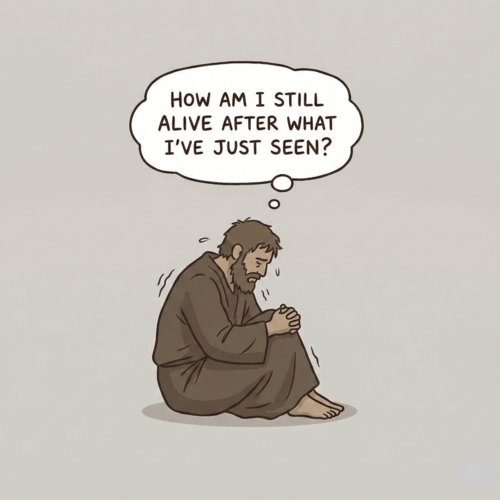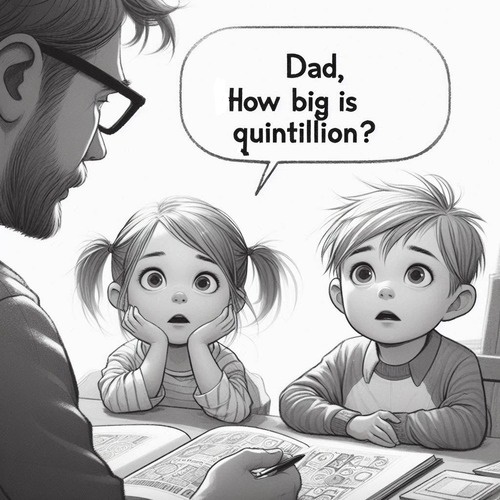The Gap Theory Exposed: Why Embrace a Young Earth?
The Gap Theory proposes there’s a vast time gap—millions or billions of years—between Genesis 1:1 (“In the beginning God created the heavens and the earth”) and Genesis 1:2 (“Now the earth was formless and empty”). This theory attempts to accommodate secular geological timelines while maintaining a literal six-day creation week. Popularised in the 19th century as a compromise position, it promised to harmonise Scripture with emerging scientific theories about Earth’s age.
But does the Gap Theory hold up under scrutiny, or does it undermine the Bible’s clear teaching? When we examine this theory through both scriptural and scientific lenses, we discover fatal flaws that make young earth creationism the superior biblical position.
WHAT IS THE GAP THEORY?
The Gap Theory, also known as the “Ruin-Reconstruction Theory,” suggests God originally created a perfect world in Genesis 1:1, which was then destroyed—often attributed to Satan’s fall or divine judgment. This destruction left the earth “formless and void” (Genesis 1:2), after which God recreated and replenished everything in six literal days.
This theory emerged in the early 1800s through Scottish theologian Thomas Chalmers and gained widespread acceptance through the Scofield Reference Bible. Its appeal was obvious: it seemed to preserve biblical authority while accommodating the millions of years demanded by uniformitarian geology. Christians could accept both a literal six-day creation and deep time geology without apparent conflict.
The theory offered what appeared to be the best of both worlds—maintaining biblical literalism while embracing secular scientific timelines. For many sincere believers, it provided a way to defend Scripture against geological challenges while avoiding the perceived difficulties of young earth creationism.
SCRIPTURAL PROBLEMS WITH THE GAP THEORY
Lack of Biblical Support: The Gap Theory faces immediate problems from Scripture itself. Genesis 1 presents a sequential, unified account of creation with no textual evidence for any gap. The narrative flows naturally from verse 1 to verse 2 without interruption or indication of vast time periods.
More decisively, Exodus 20:11 states God created “the heavens and the earth, the sea, and all that is in them” in six days. This comprehensive statement leaves no room for a prior creation in Genesis 1:1 followed by recreation in Genesis 1:3-31. If God made everything in six days, there cannot be a gap of millions of years between an initial creation and its recreation.
Theological Issues: The Gap Theory creates serious theological problems that undermine core biblical doctrines. Most critically, it introduces death before Adam’s sin, directly contradicting Romans 5:12, which clearly states that “sin entered the world through one man, and death through sin.” If millions of years of geological history occurred before Genesis 1:2, then death, disease, and destruction dominated Earth long before human sin.
This contradiction extends to God’s character. Genesis 1:31 declares God saw everything He had made as “very good.” How can a creation filled with millions of years of death and suffering be described as “very good”? The Gap Theory makes God the author of death and suffering rather than sin, fundamentally altering the gospel message.
Hebrew Grammar: The Hebrew text itself demolishes the Gap Theory. The conjunction waw at the beginning of Genesis 1:2 connects verses 1 and 2 without suggesting any chronological break. Hebrew grammar indicates continuation, not a gap of vast time.
The phrase “without form and void” (tohu wabohu) describes an initial, unformed state—not a ruined condition. When Scripture uses these terms elsewhere, they describe something unorganized or undeveloped, not something destroyed. The text presents God beginning with unformed matter and progressively organising it into the completed creation.
SCIENTIFIC PROBLEMS WITH THE GAP THEORY
Geological Evidence: The fossil record, often cited to support deep time, actually provides strong evidence for rapid burial consistent with Noah’s flood, not millions of years of gradual deposition. Polystrate fossils—trees extending through multiple rock layers—demonstrate rapid burial conditions that contradict slow, uniform geological processes.
Radiometric dating methods, foundational to old-earth geology, rely on unprovable assumptions about initial conditions, constant decay rates, and closed systems. These methods frequently yield conflicting results and consistently produce ages that contradict known historical events when applied to rocks of known age.
Astronomical Observations: Young earth models successfully explain distant starlight through mechanisms like Humphreys’ time dilation model, which doesn’t require billions of years. Meanwhile, astronomical observations reveal problems for vast age assumptions. Spiral galaxies maintain their structure despite rotation rates that should have wound them up tight long ago. Planetary magnetic fields decay too rapidly to survive billions of years.
These observations align with recent creation but pose significant challenges for deep time models. The Gap Theory doesn’t solve these problems—it simply accepts the same problematic assumptions that lead to evolutionary conclusions.
Biological Consistency: Genetic entropy and observed mutation rates indicate that life cannot survive millions of years without severe degradation. The human genome shows clear signs of recent origin, with mutation loads that would be impossible to survive over vast time periods.
Recent discoveries of soft tissue, DNA, and proteins in dinosaur fossils provide powerful evidence for recent burial. These biological materials cannot survive millions of years under any known preservation conditions. Their presence in “ancient” fossils supports a young earth timeline while challenging deep time assumptions.
WHY YOUNG EARTH CREATIONISM IS SUPERIOR
Biblical Authority: Young earth creationism takes Genesis 1 as straightforward historical narrative, consistent with how Jesus Himself referenced creation. In Mark 10:6, Jesus stated that God made mankind “from the beginning of creation”—not after billions of years. This approach maintains biblical authority without compromising Scripture to accommodate secular theories.
The young earth position avoids the theological gymnastics required by gap theory proponents. It preserves the connection between sin and death, maintains God’s character as Creator of a “very good” world, and upholds the reliability of Scripture from the very first verse.
Scientific Coherence: Young earth creationism provides a coherent framework for understanding geological and fossil evidence through Noah’s flood. This catastrophic event explains rapid sedimentation, massive fossil graveyards, and geological formations worldwide. Observable processes like rapid canyon formation, quick fossilization, and fast rock formation support this model.
The evidence consistently points to recent, rapid processes rather than slow, gradual change over vast ages. Young earth models explain scientific observations while maintaining biblical truth.
Philosophical Consistency: Most importantly, young earth creationism maintains philosophical consistency by establishing God’s Word as the ultimate authority. Rather than subjecting Scripture to human speculation about unobservable past events, it begins with divine revelation and interprets evidence accordingly. This approach provides a stable foundation for understanding both Scripture and science.
CONCLUSION: THE GAP THEORY EXPOSED
The Gap Theory fails on multiple levels. It lacks biblical support, introduces theological contradictions, and doesn’t solve the scientific problems it claims to address. By attempting to harmonise Scripture with secular geology, it compromises both biblical authority and scientific integrity.
Young earth creationism offers a superior alternative that honours Scripture’s clear teaching while providing a robust framework for understanding scientific evidence. It maintains theological consistency, preserves biblical authority, and explains observable phenomena through God’s revealed truth.
The choice is clear: we can trust God’s Word from the very first verse, or we can compromise Scripture to accommodate human theories. When we embrace young earth creationism, we’re not just choosing a position about Earth’s age—we’re choosing to build our worldview on the solid foundation of Scripture.
THE GAP THEORY EXPOSED: RELATED FAQs
What do Reformed theologians say about the Gap Theory? Most Reformed young earth proponents strongly reject the Gap Theory as compromising Scripture’s authority. John MacArthur argues the theory undermines biblical inerrancy by forcing foreign concepts into the text that aren’t grammatically or contextually supported. RC Sproul similarly emphasised faithful exegesis requires taking Genesis at face value rather than accommodating secular theories. Reformed theology’s commitment to sola scriptura naturally leads to rejecting compromise positions like the Gap Theory.
- How does the Gap Theory affect the doctrine of original sin? The Gap Theory creates serious problems for understanding original sin and human nature. If death and suffering existed for millions of years before Adam, then these weren’t consequences of human rebellion but original features of creation. This undermines the biblical teaching that humans were created in God’s image in a perfect world, making sin and death foreign intrusions rather than original design flaws. The theory essentially makes God responsible for evil rather than human choice.
- What about the “sons of God” in Genesis 6—does this support the Gap Theory? Some Gap Theory proponents claim the “sons of God” in Genesis 6:2 were angels from a pre-Adamic civilisation, but this interpretation lacks biblical support. The context clearly indicates these were descendants of Seth (the godly line) who intermarried with descendants of Cain (the ungodly line). Even if these were angels, nothing in the text suggests they were survivors from a previous creation destroyed in a gap. The passage describes corruption of the post-Adam world, not remnants of a pre-Adam civilisation.
How do young earth creationists explain Satan’s fall if not in a gap? Young earth creationists typically place Satan’s fall either between Genesis 1:31 and Genesis 3:1, or understand it as occurring in the spiritual realm outside the physical timeline described in Genesis. Some suggest Satan fell during the creation week itself, between his creation and the temptation in Eden. The biblical text doesn’t require millions of years for Satan’s rebellion—spiritual beings can make instantaneous moral choices. The Gap Theory unnecessarily complicates this by inserting unbiblical timeframes.
- Did any church fathers or early theologians teach the Gap Theory? The Gap Theory is a modern invention with no historical precedent in church history. Early church fathers like Augustine, Basil, and Chrysostom interpreted Genesis as describing recent creation without any gaps. Medieval theologians similarly understood Genesis chronologically. The theory emerged only in the 19th century as a response to uniformitarian geology, making it a recent compromise position rather than historic Christian teaching. This lack of historical support weakens its credibility significantly.
- How does the Gap Theory relate to the day-age theory and other old-earth positions? The Gap Theory, day-age theory, and framework hypothesis all represent attempts to accommodate deep time while maintaining some biblical authority. However, they each face similar problems: forcing non-literal interpretations onto clear biblical language, accepting secular assumptions about earth’s history, and creating theological inconsistencies. Young earth creationists argue that all these positions compromise Scripture unnecessarily, since the scientific evidence actually supports recent creation when properly interpreted within a biblical framework.
What practical implications does rejecting the Gap Theory have for Christian education and apologetics? Rejecting the Gap Theory strengthens Christian education by teaching students to trust Scripture’s clear meaning rather than constantly reinterpreting it to accommodate secular theories. This builds confidence in biblical authority and provides a solid foundation for Christian worldview. In apologetics, the young earth position offers a consistent, defensible framework that doesn’t require constant compromise with changing scientific fashions. It also provides answers to common objections while maintaining the gospel’s integrity regarding sin, death, and salvation.
THE GAP THEORY EXPOSED: OUR RELATED POSTS
Editor's Pick

The Throne-Room Vision: Who Did Isaiah See?
The scene is unforgettable: Isaiah stands in the temple, and suddenly the veil between heaven and earth tears open. He [...]

The Angel of the Lord: Can We Be Certain It Was Christ All Along?
Throughout the Old Testament, a mysterious figure appears: the Angel of the LORD. He speaks as God, bears God’s name, [...]
SUPPORT US:
Feel the Holy Spirit's gentle nudge to partner with us?
Donate Online:
Account Name: TRUTHS TO DIE FOR FOUNDATION
Account Number: 10243565459
Bank IFSC: IDFB0043391
Bank Name: IDFC FIRST BANK






